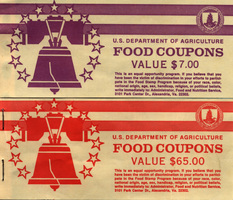 | Back to e-WV
| Back to e-WV
 The West Virginia Encyclopedia
The West Virginia Encyclopedia
 | Back to e-WV
| Back to e-WV
 The West Virginia Encyclopedia
The West Virginia Encyclopedia

On May 29, 1961, Alderson Muncy of Bradshaw, McDowell County, an unemployed miner and father of 15 children, and his wife, Chloe, received the first food stamps in the nation. The purpose of the new federal program was to provide supplemental income for welfare recipients and families below certain levels of income. Prior to 1961, surplus commodities were distributed to the needy. Because of its high unemployment and poverty rates, West Virginia had always been a major focus of this program. Muncy took his stamps to John Henderson’s supermarket in Welch and bought two watermelons.
In his campaign for the presidential nomination in 1960, Sen. John F. Kennedy paid several visits to West Virginia and was moved by the malnutrition and poverty he observed. As president, Kennedy directed the government to establish a pilot food stamp program, with low-income families to be issued food stamps, which could then be exchanged at grocery stores. West Virginia was the first of eight states to issue food stamps. The Food Stamp Act of 1964 made the program permanent. West Virginia became the first state to implement the program statewide. The stamps were later replaced by coupon books.
The bulk of the funding for the food stamp program comes from the U.S. Department of Agriculture, which also sets guidelines and audits the state-administered programs. In West Virginia, public assistance agencies administer the program. In 2001, the West Virginia Department of Health and Human Resources (DHHR) assumed this responsibility.
For several years prior to 2001, the West Virginia program was sanctioned by the federal government for its high error rate. Following steps to correct deficiencies, the federal sanction against West Virginia was lifted, and in May 2001 the U.S. Department of Agriculture awarded the state extra funding of $1.9 million for its outstanding performance.
On October 1, 2008, the name of the food stamp program was changed to the Supplemental Nutrition Assistance Program, or SNAP.
The number of recipients of food stamps per capita has always been high in West Virginia. The formula is based on each household’s income, assets, household size, and other non-financial factors. In 2019, more than 300,000 West Virginians (about 17 percent of the population) were receiving SNAP benefits. New policies and work requirements were enacted to reduce that number; however, the COVID-19 pandemic, which began in 2020, closed businesses and put employees out of work. DHHR responded in April 2020 by increasing SNAP benefits to the maximum amount on an emergency basis. As the pandemic waned, these emergency allotments ended on March 1, 2023, reducing SNAP benefits for approximately one-third of West Virginians.
Written by Ken Hechler
White, Julia. Unite Us Member Discusses the Impact of SNAP Benefit Cuts in West Virginia. WVNS-TV, March 29, 2023.
West Virginia Department of Health & Human Resources. DHHR Reminds Residents that SNAP Emergency Allotments are Ending in March. Charleston, WV: West Virginia Department of Health & Human Resources, January 23, 2023.
West Virginia Department of Health & Human Resources. DHHR Receives Federal Waivers to Assist SNAP Recipients During COVID-19 Response. Charleston, WV: West Virginia Department of Health & Human Resources, March 31, 2020.